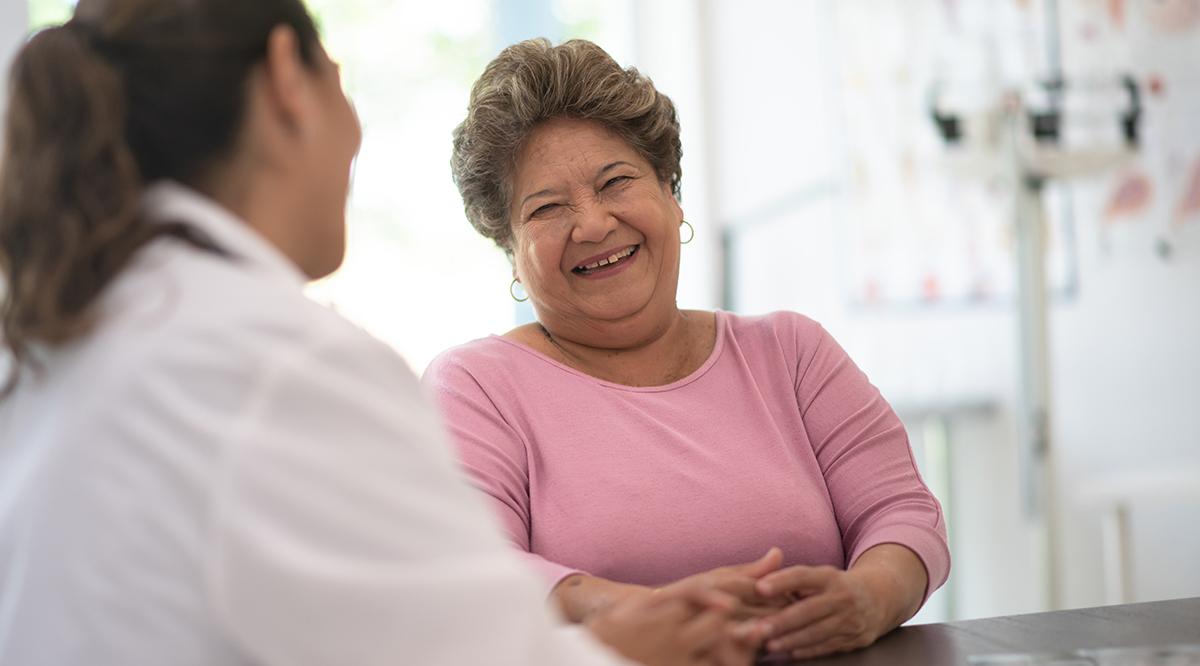Growing up as a second-generation Mexican immigrant in Boyle Heights, California, Laura Martinez, PhD, attended her parents’ medical appointments to help bridge the language barriers they faced. Despite their efforts to learn English, Martinez’s parents struggled to understand and communicate with their doctors who didn’t speak Spanish.
“It was very important for me to be a proponent for their health,” Martinez says.
These experiences interpreting for her parents, and later volunteering at Los Angeles General Medical Center, made Martinez very aware of the challenges that arise when medical providers are not able to communicate with their patients in those patients’ most comfortable language. That’s why Martinez decided to research language concordance — a term for effectively communicating in a shared language — and the Latino physician workforce at the University of California Los Angeles (UCLA) Latino Policy and Politics Institute.
Research shows that patients without language-concordant health care providers are more likely to experience miscommunication and adverse events, are less likely to comply with medications and medical advice, and are less likely to come to follow-up appointments.
This presents a serious challenge to achieving health equity for Spanish-speaking patients, says Yohualli Anaya, MD, an associate professor of family medicine and community health at the University of Wisconsin School of Medicine and Public Health.
“When we have examined the representation of languages within the physician workforce, Spanish was the most underrepresented of all the languages in comparison to population,” says Anaya, who co-directs the UCLA Center for the Study of Latino Health and Culture’s Accelerating Latinx Leadership Institute.
According to the U.S. Census Bureau, Hispanic people make up 19% of the total U.S. population, and nearly 70% of them — 42 million people — speak Spanish at home. Yet, only 6% of physicians identify as Hispanic and just 2% of non-Hispanic physicians are Spanish-speaking, Anaya says.
Addressing these disparities requires a multi-pronged approach, adds Pilar Ortega, MD, MGM, vice president of diversity, equity, and inclusion for the Accreditation Council for Graduate Medical Education and a clinical associate professor in the departments of emergency medicine and medical education at the University of Illinois at Chicago College of Medicine, where she developed the medical Spanish program.
“With all the complexity of this issue, it’s not enough to tackle this just from the educational angle, it’s not enough just to do policy, it’s not enough to do research alone,” Ortega says. “It’s multidimensional.”
Experts like Martinez, Anaya, and Ortega say that academic medicine must do more to recognize the need for language concordance to provide better and more equitable care to Spanish-speaking patients, including by recruiting and retaining more Hispanic, Latino, and multilingual doctors, by creating minimum standards for medical Spanish proficiency, and by providing more language training to medical students and physicians to enhance their ability to communicate with and relate to their patients.
“People have this idea — they subtly blame patients for not speaking English,” Ortega says. “For English speakers, it is considered a given that the patient and doctor will be able to communicate, but when a patient with non-English language preference comes in, we are often scrambling to find ways to get by. That’s the definition of inequity.”
The complexity of communication
There are factors apart from a physician’s medical expertise and judgment that can influence health care outcomes, and among those is a physician’s ability to relate to and communicate with patients.
A body of research suggests that patients from minoritized races tend to fare better with doctors of the same race. One study found that infant mortality among Black newborns was lower when their physician was also Black, compared to those with a White physician. Other studies suggest Black patients are more likely to bring up health concerns in appointments and to take medication as prescribed when they have a Black doctor.
The same factors that can negatively influence interactions between Black patients and non-Black physicians — bias, lack of cultural understanding, mistrust — also arise in interactions between Latino patients and non-Latino physicians. When there is a language barrier on top of racial discordance, that creates an additional challenge to the relationship, Anaya says.
“It’s a layered issue,” she says. “And when it comes to equity in health care, it’s hard to separate language concordance from racial and ethnic concordance.”
That’s why her focus is on empowering and growing the Hispanic and Latino physician workforce.
“Over a 20-year span, the numbers [of Latino physicians] haven’t really been changing,” she says. “It’s time to see some objective and sustained growth in the number of Latino physicians.”
In a policy brief written for the UCLA Latino Policy and Politics Initiative in 2018, Anaya and her co-authors calculated that it would take 500 years to reach parity between Latino physicians and the Latino population in California — which is now 40% Latino — if medical schools continue to graduate Latinos at the current rate. The brief recommended increasing medical school admissions for Latino students, recruiting Latino out-of-state physicians, expanding opportunities for Latino international medical graduates, and creating a state-funded, Spanish-language residency pilot program.
Ortega emphasizes the need to recognize the Spanish language skills that Hispanic and Latino medical students and residents learn from their families as an asset and offer them the training to professionalize these language skills.
“I think there’s a bit of a paradox in how language is viewed,” she says. “Whether it is viewed as a skill set that will benefit patient care and patient communication or whether it is viewed as a nice plus, but not as a core skill.”
Often, she points out, medical students who grew up speaking Spanish may have varying levels of proficiency and may not have learned Spanish that is specific to medical terminology. When Spanish-language programs at medical schools only target beginners — which Ortega says many do — it does a disservice to these “heritage speakers,” who could benefit from more specific training that could advance their skills and provide even better care for Spanish-speaking patients.
“They have the ingredients to be able to do that,” she says. “We go into medical school with all the ingredients to be good doctors, then we get training to really refine our skills. In most U.S. medical schools, we only do that in English. We need to do the same for other languages.”
Recent efforts by advocates and professionals in medical Spanish proficiency have focused on developing a standardized assessment to measure a physician's competency in medical Spanish and an educational curriculum to train a physician workforce that can aptly care for patients in the language.
On the policy side, there has been more emphasis on employing professional medical interpreters than on training and assessing bilingual physicians, Ortega says.
And while interpreters are critically important and helpful, they often are not available or are underutilized, she says.
That’s why she founded the National Association of Medical Spanish, an interdisciplinary group working to create a standardized, evidence-based approach to teaching medical Spanish and assessing bilingual medical providers.
“Language is … dynamic. It’s not something you learn one day and you’re done, ‘Now I’m fluent,’” Ortega says. “Even if you grow up speaking Spanish … if you have never used it in the professional setting, you might not be able to communicate directly with your patients. There’s all this complexity.”
The goal, she says, is not to achieve perfect bilingualism, but to improve clinicians’ abilities to communicate effectively with their patients, including knowing when they need to ask for help from an interpreter.
“It’s not a failure of your skills,” Ortega says. “It’s communication skills and humility we try to teach all students.”
Education in Spanish
While empowering existing Latino physicians and bolstering the Latino physician workforce — including supporting pathway programs that start in elementary school and continue through the educational journey — are essential to achieving better physician-patient language concordance, it’s also important for non-Latino medical students and trainees to have opportunities to improve their Spanish language communication skills, especially if practicing in areas where most of the patient population speaks Spanish and has limited English proficiency, Martinez says.
“Realistically, you’re not always going to have that matched background until we reach more diversity,” she says. “Even if you don’t have racial and cultural concordance, that doesn’t mean we can’t work on these [language concordance] efforts.”
A few medical schools are finding ways to incorporate medical Spanish proficiency into training the next generation of physicians.
In 2018, Indiana University School of Medicine created a Care of Hispanic/Latino Patients Scholarly Concentration (the equivalent of a minor in undergraduate school) at its West Lafayette campus.
“We train them to understand and apply culturally appropriate medical care, feel comfortable with Spanish in a clinical setting, and most importantly, understand the needs of the population,” says Ray Munguia-Vazquez, MD, PhD, a clinical assistant professor of otolaryngology-head and neck surgery, who runs the program.
The scholarly concentration started out with a few students who were of Hispanic or Latino heritage, but as the program has grown, it’s attracted more students who are not culturally Hispanic or Latino but who have at least intermediate Spanish skills and an interest in working in the Hispanic-Latino community.
While Indiana doesn’t have the number of Hispanic and Latino residents that states like California, Texas, and Florida do, Munguia-Vazquez says there is a significant population of Spanish-speaking migrants who come to work on the farms in the area. Spanish speakers might struggle even more to access cultural and language concordant medical care in these rural, Midwestern areas that don’t have as many resources as larger, more populous states, he adds.
“That’s why it’s important for us to offer that [scholarly concentration] to our students,” Munguia-Vazquez says. “So they can develop their skills, not just language skills, but get better at understanding the needs of the population. It makes them better physicians.”
In El Paso, Texas, more than 80% of the 3 million residents in the metro area are Hispanic.
For this reason, Texas Tech University Health Sciences Center (TTUHSC) El Paso, which welcomed its first medical school class in 2009, was founded with the goal of training physicians with Spanish language skills, says Richard Lange, MD, president of TTUHSC El Paso and dean of the Paul L. Foster School of Medicine.
Spanish language instruction is a required and fully integrated component of the medical school’s preclerkship curriculum, explains Richard Brower, MD, assistant vice president for academic affairs.
Once admitted, students’ Spanish language skills are assessed, and they’re placed into classes appropriate to their level. First-year students arrive on campus a month before biomedical science classes begin to participate in a Spanish language and community immersion program as a kick-start to their medical school experience. Then, throughout the preclerkship years, students have weekly medical Spanish language classes, designed and taught by professional Spanish language instructors, that complement the clinical science and skills content for each week of instruction.
While there is no Spanish proficiency test that students must pass, each student is given a realistic goal to advance their skills, Brower says. They’re then graded on effort and engagement and assessed based on their improvement.
“I think the clinical effects extend beyond translation or formal interpretation,” he says. “Most students don’t reach independence, but it’s about building on existing skills and the ability to establish rapport and trust. … Even just introducing themselves, asking questions, picking up on humor or distress … It’s a big plus.”
In El Paso, being able to communicate with Spanish-speaking patients is a necessity for providing appropriate care, but as the Hispanic population grows it’s becoming more relevant throughout the country as well, Lange says.
“It has to be a priority; It’s not an add-on,” he says. “You don’t buy Rosetta Stone and give it to students and say, ‘Here is the language, learn it.’”

